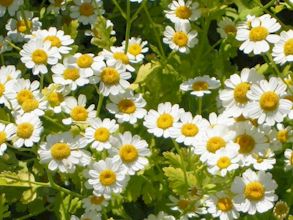|

Feverfew |
The Feverfew is one of the wild Chamomiles (Pyrethrum Parthenium), or Matricaria, so called because especially useful for motherhood. Its botanical names come from the Latin febrifugus, putting fever to flight, and parthenos, a virgin. The herb is a Composite plant, and grows in every hedgerow, with numerous small heads of yellow flowers, having outermost white rays, but with an upright stem; whereas that of the true garden Chamomile is procumbent.
The whole plant has a pungent odor, and is particularly disliked by bees. A double variety is cultivated in gardens for ornamental purposes.
The herb Feverfew is strengthening to the stomach, |
preventing hysteria and promoting the monthly functions of women. It is much used by country mediciners, though insufficiently esteemed by the doctors of to-day.
In Devonshire the plant is known as "Bachelor's buttons," and at Torquay as "Flirtwort," being also sometimes spoken of as "Feathyfew," or "Featherfull."
Gerard says it may be used both in drinks, and bound on the wrists, as of singular virtue against the ague.
As "Feverfue," it was ordered, by the Magi of old, "to be pulled from the ground with the left hand, and the fevered patient's name must be spoken forth, and the herbarist must not look behind him." Country persons have long been accustomed to make curative uses of this herb very commonly, which grows abundantly throughout England. Its leaves are feathery and of a delicate green color, being conspicuous even in mid-winter. Chemically, the Feverfew furnishes a blue volatile
oil; containing a camphoraceous stearopten, and a liquid hydrocarbon, together with some tannin, and a bitter mucilage.
The essential oil is medicinally useful for correcting female irregularities, as well as for obviating cold indigestion. The herb is also known as "Maydeweed," because useful against hysterical distempers, to which young women are subject. Taken generally it is a positive tonic to the digestive and nervous systems. Out chemists make a medicinal tincture of Feverfew, the dose of which is from ten to twenty drops, with a spoonful of water, three times a day. This tincture, if
dabbed oil the parts with a small sponge, will immediately relieve the pain and swelling caused by bites of insects or vermin. In the official guide to Switzerland directions are given to take "a little powder of the plant called Pyrethrum roseum and make it into a paste with a few drops of spirit, then apply this to the hands and face, or any exposed part of the body, and let it dry: no mosquito or fly will then touch you." Or if two teaspoonfuls of the tincture are
mixed with half a pint of cold water, and if all parts of the body likely to be exposed to the bites of insects are freely sponged therewith they will remain unassailed. Feverfew is manifestly the progenitor of the true Chamomilla (Anthemis nobilis), from which the highly useful Camomile "blows," so commonly employed in domestic medicine, are obtained, and its flowers, when dried, may be applied to the same purposes. An infusion of them made with boiling water and
allowed to become cold, will allay any distressing sensitiveness to pain in a highly nervous subject, and will afford relief to the faceache or earache of a dyspeptic or rheumatic person.
This Feverfew (Chrysanthemum parthenium), is best calculated to pacify those who are liable to sudden, spiteful, rude irascibility, of which they are conscious, but say they cannot help it, and to soothe fretful children. "Better is a dinner or such herbs, where love is; than a stalled ox, and hatred therewith."
Herb Simples
The Primitive Simplers presented here show the way of life in other generations, it is not suggested or recommended trying them yourself. |
|
Garden
Herbs
Home
History of Herbs
Herb Gardening
Herbs for Beginners
Drying & Preserving Herbs
Indoor Herb Gardening
Herb Garden
Hints & Tips
Herbal
Cooking
Herb Chart
Using Herbs
Culinary Herbs
Herb
Oil and Vinegar
Herb Teas
Herb Candy
Herb Jelly
Herb Simples
Preface
Introduction
Alphabetical Listing

Trade
Recipes Online
Share your Recipes with others!!
|


